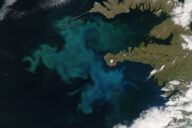Taking a dip: One professor’s nationwide secchi disk program tracks lake data
0 This time of year, you can find Bob Carlson, Kent State Professor Emeritus, relaxing at his summer cabin in Minnesota, looking out over “gorgeous” Clearwater Lake. He can tell you that it is seven miles long, 110 feet deep, and that the cliffs surrounding the lakes were gouged out by glaciers. He can also tell you that it’s the clearest natural lake in the state.
This time of year, you can find Bob Carlson, Kent State Professor Emeritus, relaxing at his summer cabin in Minnesota, looking out over “gorgeous” Clearwater Lake. He can tell you that it is seven miles long, 110 feet deep, and that the cliffs surrounding the lakes were gouged out by glaciers. He can also tell you that it’s the clearest natural lake in the state.
This time of year is also significant to Carlson because the Secchi Dip-In has just wrapped up, and volunteers from across the country are sending in lake transparency data to be organized and entered into a database. Now in its 18th year, Carlson’s program encourages local participation in lake monitoring to track changes and trends in lakes across the country.
The Secchi Dip-In began in 1994, funded by the Environmental Protection Agency’s Office of Water and the North American Lake Management Society. The first Dip-In included Midwest states; the next year, it expanded to include the entire country. Any program or individual qualified in transparency monitoring of freshwater can participate. Carlson encourages previously established programs to participate.
“We didn’t want to compete with individual programs,” Carlson said. “In fact, a lot of the purpose of the Dip-In is to get volunteers to get active in their local programs.”
Dip-In organizers contact watershed and monitoring programs across the country about participating in the Dip-In, which lasts approximately three weeks every summer. Program coordinators then contact members. Those who do participate must take either secchi disks or transparency tubes and record the transparency of a lake, river or estuary in their area. They then enter the data in the Dip-In website which includes data from past years, information on how to use and make a secchi disk, and other parameters that could be recorded such as temperature and oxygen. Those who are not volunteers can simply log on to the website as a guest to view lake data from the United States as well as nine other countries. It’s the importance of the “big picture” idea that Carlson wants participants to understand.
“It’s a matter of trying to convince people that this is greater than their own local efforts, and that it’s worthwhile for them to participate,” Carlson said.
Participation has greatly decreased recently due to monetary concerns. Funding was radically reduced in 2002 and will be completely gone in October. Carlson and his team had to convert to using email for all their communication with participants, cutting out letters and newsletters. Because of this, participation has plummeted from over 3,000 at the program’s peak to just 800 last year. Carlson will still be able to keep the website going, but he needs funding for expansion and equipment. A donation page may soon be on the website.
Carlson hopes that local pride in lakes will keep the secchi disks in the water. For many volunteers, the satisfaction of producing data and information for their communities is pay enough to keep them dipping. Carlson gave the example of the passionate Ohio volunteers who continue to monitor Indian Lake, which has a transparency of 1 to 2 feet.
“They like it just as much as people in Minnesota with lake transparencies of 12 to 14 feet,” Carlson said.
For other volunteers, it’s simply the curiosity of knowing about the water that surrounds them. Tracking transparency data can allow officials and volunteers to understand what may be causing low transparency, thus leading to improvements in the aquatic environment and monitoring of other parameters. Carlson hopes the future of the Dip-In will include recording trends in other water quality data such as chlorophyll, phosphorus, and even invertebrates.
“I’m a scientist; I want to do something with the data,” Carlson said. “But the program seems to capture people’s imaginations and makes them wonder ‘Gee, wouldn’t it be nice to learn something about my lake?’”
Image Credit: Flickr













